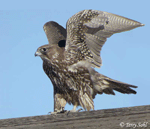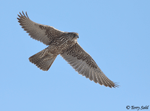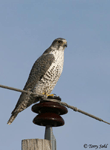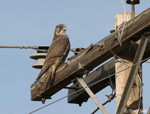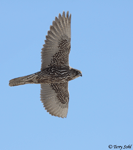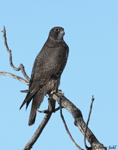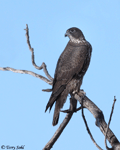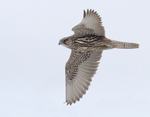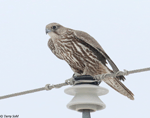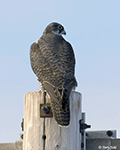Gyrfalcon
Falco rusticolus
| Length: 20 - 25 inches | Wingspan: 48 - 64 inches | Seasonality: Winter |
| ID Keys: Large size, broad wings, long tapered tail. Multiple color phases occur, but the gray phase (pictured below) is by far the most common in South Dakota. | ||
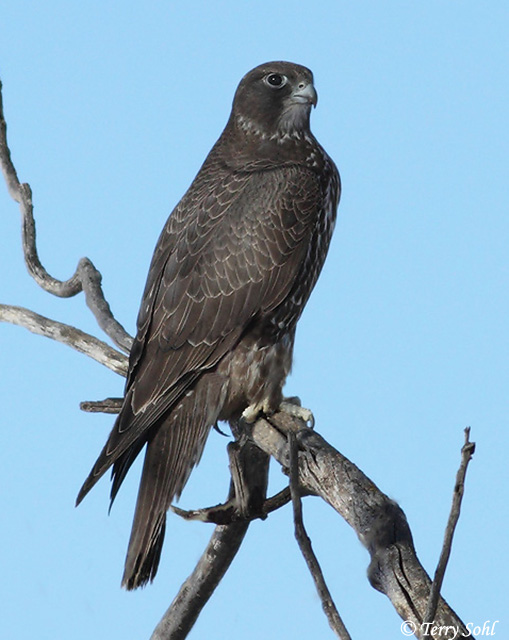 The Gyrfalcon is the
largest falcon in the world, and are about the same size as North America's
ubiquitous Red-tailed Hawk.
Three color phases can be found, a gray morph, a dark morph (an immature dark
morph is pictured in the photo to the right), and a stunning white morph.
Links to photos of immature gray morph birds can be found at the bottom, along
with additional mature bird photos. Generally a bird of the Arctic, a few may
wander south in the winter, but it is a rare visitor to South Dakota. The
vast majority of overwintering Gyrfalcons in South Dakota are gray-morph birds,
with immature birds more likely to visit the state than adult birds. Dark morphs
are less commonly seen. The heaviest concentration of white-morph birds in
the Western Hemisphere is northern Greenland, a population less likely to
overwinter in South Dakota, and thus white-morph Gyrfalcons are an extremely
rare sight in South Dakota.
The Gyrfalcon is the
largest falcon in the world, and are about the same size as North America's
ubiquitous Red-tailed Hawk.
Three color phases can be found, a gray morph, a dark morph (an immature dark
morph is pictured in the photo to the right), and a stunning white morph.
Links to photos of immature gray morph birds can be found at the bottom, along
with additional mature bird photos. Generally a bird of the Arctic, a few may
wander south in the winter, but it is a rare visitor to South Dakota. The
vast majority of overwintering Gyrfalcons in South Dakota are gray-morph birds,
with immature birds more likely to visit the state than adult birds. Dark morphs
are less commonly seen. The heaviest concentration of white-morph birds in
the Western Hemisphere is northern Greenland, a population less likely to
overwinter in South Dakota, and thus white-morph Gyrfalcons are an extremely
rare sight in South Dakota.
Habitat:
During the summer breeding season, Gyrfalcons are found in open tundra and in and around coastal area. Tundra with nearby cliffs and/or rocky outcrops serve as areas that provide both prey (often ptarmigan) and rocky sites for nesting. They will also use rocky cliffs and shorelines, often breeding relatively near reliable foraging opportunities such as large seabird colonies. Those that migrate south in the winter are usually found along the coast, or in very open country. In South Dakota, they are found in open grasslands of the central and western part of the state.
Generally thought to inhabit open lands such as the Arctic Tundra or open prairies, Gyrfalcon have also been found to inhabit open sea-ice in areas far from land, where they may hand out near the ice edge and feed on gulls and other seabirds that overwinter in such habitats.
Diet:
Gyrfalcons primarily feed on birds, especially ptarmigans in its normal Arctic range. Coastal Gyrfalcons may feed heavily on ducks, geese, and gulls. They will also take small mammals given the opportunity. In South Dakota, Gyrfalcons on the open prairies of the central and western part of the state may focus on Ring-necked Pheasant, Sharp-tailed Grouse, and Greater Prairie Chickens, but they will also take smaller prey, including pursuit of the large mixed flocks of Horned Larks, Lapland Longspurs, and Snow Buntings that are often found in open South Dakota habitats during the winter months. They may also hang out near what are sometimes the precious few spots of open water in northern South Dakota in winter, targeting waterfowl that are attempting to overwinter. I've personally seen them take prey as large as a Canada Goose.
Behavior:
Hunts from either a perch or while in flight. Prey is often taken by surprise as the Gyrfalcon approaches close to ground. Very strong fliers, Gyrfalcons may also pursue prey over very long distances, doggedly pursuing them until exhaustion allows for an easier capture.
Breeding:
Non-breeder in South Dakota. On their breeding grounds, Gyrfalcons do not build nests, instead using existing nests of birds like Golden Eagles or Common Ravens, or nesting directly on a protected cliff site. The female lays between 3 and 5 white or pale eggs with reddish brown spots, and she alone incubates them. The young hatch after 30 to 36 days, and fledge from the nest another 40-45 days after hatching.
Song:
Gyrfalcons are usually silent in migration and during the winter months. I have never heard a Gyrfalcon vocalize from those I've seen in South Dakota. They will make a loud keya-keya call near the nest or harsh kak-kak-kak and other calls. They will aggressively defend a large region around nest sites, and will often vocalize while doing so.
- Click here to hear alarm calls of a Gyrfalcon1
- Click here to hear the begging calls of a Gyrfalcon near a nest site2
Migration:
Many birds are permanent residents throughout its range. Those at the northernmost extreme of the breeding range may move south in the winter. A very few may move south into the United States in the winter, with immature birds the most likely to wander the furthest. In South Dakota they are most likely to be seen in December through March.
Interactive eBird Map:
Click here to access an interactive eBird map of Gyrfalcon sightings
Similar Species:
The largest falcon in the world, size is one clue to identifying a Gyrfalcon, but size is often a difficult feature to judge on a bird seen in isolation in the field. Gyrfalcons could potentially be confused with a couple of other falcon species found in South dakota.
- Prairie Falcon - Of the three larger falcons listed here, Prairie Falcons are by far the most commonly seen species in South Dakota. Seasonality is one clue to differentiating them from Gyrfalcons, as Prairie Falcons can be found year-round in South Dakota (with breeding birds during the summer months confined to the far western edge of the state), while Gyrfalcons are winter visitors (mostly found from December through mid-March). Prairie Falcons are a smaller bird, but size can be difficult to judge in the field. In terms of appearance, Prairie Falcons can be differentiated from Gyrfalcons by their dark "armpits" seen in flight, as well as more tapered, narrow wings than a Gyrfalcon. Plumage on the head is also a clue, as a Prairie falcon has a very distinct mustache with clean, contrasting light feathering around it, while the mustache on a Gyrfalcon stands out less due to mottled feathering behind the mustache stripe. Prairie Falcons also have a light "eyebrow" that's generally lacking on a Gyrfalcon. Note white-phase Gyrfalcons are easily differentiated from Prairie Falcons based on overall coloring.
- Peregrine Falcon - Peregrine Falcons are primarily migrants in South Dakota, although there are rare winter visitors and some summer records in the far western part of the state that indicate potential breeding. They are a smaller bird than a Gyrfalcon, but size is difficult to judge for these two species. Facial pattern is the best clue, as Peregrine Falcons have a very strong "hooded" look with a very thick mustache that is cleanly differentiated from the surrounding lighter feathering, while Gyrfalcons have a weaker, less clearly defined mustache. On mature birds, Peregrine Falcons have a consistent dense horizontal barring on their underparts, while mature Gyrfalcons have less dense spotting.
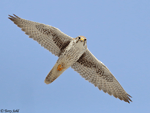 |
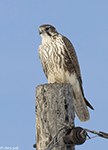 |
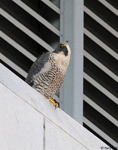 |
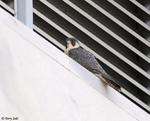 |
| Prairie Falcon | Prairie Falcon | Peregrine Falcon | Peregrine Falcon |
Status:
Populations globally are generally considered to be stable, with some increases noted in recent decades in the North American part of their range. It has declined in parts of it's Eurasian Arctic habitat, with falconry a primary cause of the decline, as Gyrfalcons are highly prized by falconers, and eggs and young birds are often taken for that purpose. Also bred in captivity for the falconry trade, individual birds typically costs several thousand dollars to prices far beyond that for some birds. Gyrfalcons are also sometimes victims of trapping activities in Russia and elsewhere. However, overall much of their range is remote from human activity, and overall populations appear to be strong. The IUCN considers the Gyrfalcon to be a species of "Least Concern".
South Dakota "Hotspot":
Gyrfalcons are always a special sighting in the lower 48, as they're very rare winter visitors overall. However, central and western South Dakota do offer one of the better chances to see a Gyrfalcon than most places in the lower 48. The Fort Pierre National Grasslands and northward up through the Pierre area (outside of town) and along both sides of Lake Oahe are good places to look, as is much of the northwestern quarter of the state. However, Gyrfalcons are generally a bird you never go out expecting to find, and exact locations can be unpredictable. They say the Muskellunge is "the fish of 10,000 casts"...searching for a Gyrfalcon generally consists of driving around through possible open habitat haunts, and they could very well be deemed "the bird of 1,000 miles".
Further Information:
- USGS Patuxent Bird Identification InfoCenter, Gyrfalcon
- BirdWeb - Gyrfalcon
- Audubon Guide - Gyrfalcon
Photo Information:
January 17th, 2010 -- Near Presho, South Dakota -- Terry L. Sohl
Additional Photos:
Click on the image chips or text links below for additional, higher-resolution Gyrfalcon photos.
Audio File Credits:
- 1Stein O. Nielsen. Recorded in Norway on July 21st, 2018. Original recording and information available from xeno-canto.
- 2Fernand Deroussen. Recorded in Finland on June 24th, 2004. Original recording and information available from xeno-canto.
| Click on the map below for a higher-resolution view |
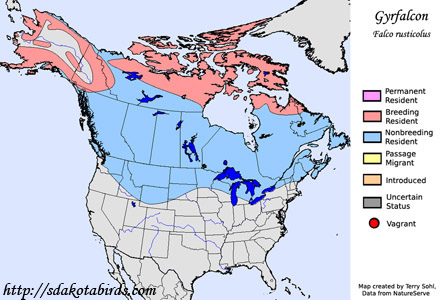 |
| South Dakota Status: Still a rare winter visitor, but the central part of the state may be one of the best place in the Lower 48 states to find a Gyrfalcon in winter. |
Additional Gyrfalcon Photos
Click for a higher-resolution version of these photos
